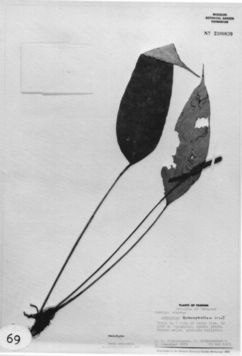




Anthurium dichrophyllum Croat, sp. nov.
TYPE: Panama. Veraguas: trail up E side of Cerro Tute, to 1,200 m, 8°33'N, 81-08'W, Witherspoon & Dressier 8870 (MO 2300839, holotype; PMA, isotype).
Planta epiphytica; cataphyllum persistens plus minusve intactum aut findens in fibris tenibus; petiolus ellipticus, 15-23 cm longus; lamina modice membranacea, lanceolato-oblonga ad oblongo-elliptica, basi anguste ad late acute, 18-21 cm longa,4.5-5.8cmlata, utrinque glanduloso-punctata; inflorescentia et pedunculus 20-23 cm longus; spatha viridis, oblongo-lanceolata, 2.5-3 cm longa, 5-6 mm lata; spadix ignolus per anthesin; baccae albae, 3-4 mm diam.
Epiphyte; stems short, ca. 1 cm diam.; internodes short, leaf scars hidden by cataphylls; roots moderately few, slender; cataphylls 1.5-2 cm long, drying reddish brown, remaining more or less intact or weathering to slender fibers.
LEAVES erect; petioles 15-23 cm long, 2-3 cm diam., about as long as or longer than the blades, elliptic in cross-section; geniculum 1-1.5 cm long; blades oblong-lanceolate to oblong-elliptic, moderately thin on drying, gradually long-acuminate at apex, narrowly to broadly acute at base, 18-21 cm long, 4.5-5.8 cm wide, the upper surface drying dark green, sparsely and conspicuously glandular-punctate with sunken epidermal cells, the lower surface much paler, densely and conspicuously glandular-punctate; midrib prominently raised on both surfaces; primary lateral veins 5-6 per side, drying scarcely or not at all more prominent than the numerous interprimary veins, weakly curved to the collective vein, weakly loop-connected, both the primary lateral and interprimary veins prominulous on both surfaces (dry); collective vein arising from the base, 2-4 mm from the margin, drying weakly sunken above, prominulous below.
INFLORESCENCE with peduncle 20-23 cm long, usually longer than the petioles; spathe green, oblong-lanceolate, 2.5-3 cm long, 5-6 mm wide, broadest just above the base, obtuse at apex and apiculate, acute and weakly decurrent at base, inserted at ca. 45° angle on peduncle; spadix oblong, scarcely tapered, spadix at anthesis not known, ca. 3 flowers visible in principal spiral, 5-6 in alternate spiral (young infructescence); lateral tepals 1.2-1.7 mm wide, the inner margins thin, almost straight, the surface coarsely granular-punctate.
INFRUCTESCENCE with spadix ca. 5 cm long, ca. 1.5 cm diam.; berries white, 3-4 mm diam., meso-carp gelatinous, with numerous raphide cells, these about as broad as long; stigma weakly raised; seeds 2, tan, ovoid to ellipsoid, somewhat flattened, 2.2-3 mm long, 1.4-1.8 mm diam., 0.4-0.8 mm thick, enveloped in a gelatinous sac, this somewhat elongate at the broadest end of the seed. Fig. 69.
Anthurium dichrophyllum is endemic to Panama and known only from Cerro Tute in Vera-guas Province in premontane rain forest at 1,100 to 1,200 m.
The species is a member of section Porphyrochitonium and is distinguished by its oblong-lanceolate to oblong-elliptic, long-petiolate, narrowly acuminate, glandular-punctate leaf blades that dry markedly bicolorous (thus the name dichrophyllum) with the primary lateral veins scarcely or not at all more prominent than the interprimary veins. It is also distinguished by its relatively short, stubby spadix and white berries.
It is most easily confused with Anthurium gracililaminum from Chiriquí Province, which has similarly shaped glandular-punctate leaf blades. The latter species has leaf blades that are much less markedly bicolorous and are eglandular or only inconspicuously glandular-punctate on the upper surface with the glands only a few times broader than the surrounding raphide cells. In A. dichrophyllum, the glands are conspicuous on the upper surface and many times larger than the surrounding raphide cells. Anthurium gracililaminum also differs in having pinkish white berries.

Map of Mesoamerican specimens with coordinates
Panama Veraguas: 1100-1400 m, 8.35N 81.05W, 15 July 1983, C. Hamilton & K. Krager 3979 (MO).